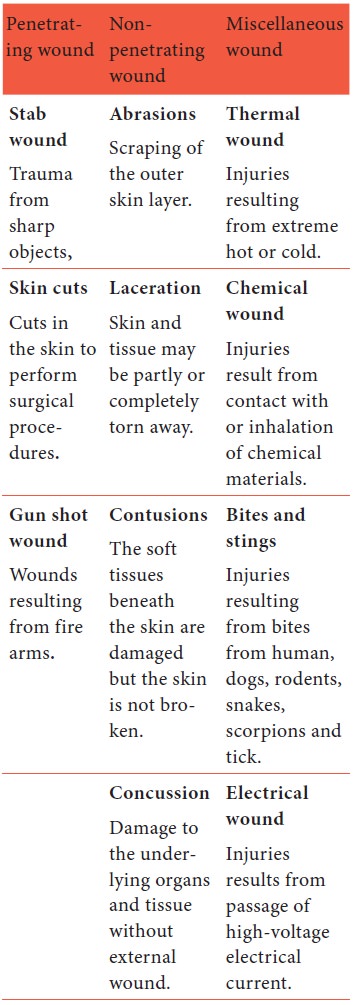Chapter: 11th Nursing : Chapter 9 : First Aid
First aid for patients with Wound, Hemorrhage, and Shock
First aid for patients with Wound, Hemorrhage, and Shock
Wounds
Any abnormal break in the skin or the body surface is known as a
wound.
Types of Wound
1.
Penetrating wound-wound that breaks through the full thickness
of skin.
2.
Non-penetrating wound-wound does not break through the skin.
3.
Miscellaneous wound


Principles of wound care
1.
To stop the bleeding
2.
To prevent infection
3.
To prevent shock
First aid for wounded patients

Hemorrhage
Haemorrhage or bleeding is a flow of blood from an artery, vein
or capillary accompanied an accident in which a wound, a fracture or damage to
organs occurs.
Bleeding can occur
internally, where blood leaks from blood vessels inside the body, or
externally, either through a natural opening such as the mouth, nose, ear,
urethra, vagina, or anus, or through a break in the skin.
Types of hemorrhage or bleeding,
a)
arterial Bleeding-blood coming from Arteries ,bright red in
colour, spurts.
b)
Venous Bleeding-blood coming from veins, dark red in colour,
flows steadily.
c) Capillary Bleeding. – blood from small blood vessels, oozes and most common.
First aid treatment for hemorrhage



Effects of Extreme Heat Stroke
·
It occurs when body can no longer controls its temperature
anymore and the body’s temperature increases to106 degree or higher within 10
to 15 minutes.
·
It is caused by very high environment temperature or illness
like malaria.
·
Exposure to heat and humidity for long time
·
Prolonged confinement in hot atmosphere.
·
Consumption of alcohol.

Management
·
Move the causality to cold place and remove the clothing.
·
If the casualty is conscious, then place him in half sitting
position with head and shoulders supported.
·
If the casualty is unconscious, then place in recovery position.
·
Wrap the casualty in a wet sheet and keep it wet. Fan should be
on.pour water all over the body. Colds ponging should be started
·
Replace the body fluids. Give cold water to drink
·
Apply ice cap with ice pieces over the head and neck.
·
Cold water enema can be given
·
If required, shift him to hospital.

HEAT CRAMPS
Heat cramps, are
muscle spasms that result from loss of large amount of salt and water through
exercise. This can be caused by inadequate consumption of fluids or
electrolytes.
Treating Heat Cramps
Identify hen you have a heat cramp typically due to
exercising or working in hot environments.
Stop the activity ein performed
Heat cramps are not
something you “push through” during exercise. They are your body’s way of
telling you that it needs a break.
Rest in a cool environment
Find a cooler spot in
the shade or indoors and give yourself time to rest and cool down
Drink plenty of fluids
The cramp is a
response to dehydration and loss of electrolytes, so you should also drink lots
of fluids while you rest. Dissolve a quarter or half teaspoon of regular table
salt into one quart of water
Gently stretch the
muscles that are cramping.
Related Topics